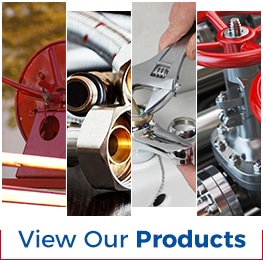
In an earlier post, we discussed the factors that make a hose suitable for use in high temperature industrial processes. In this post, we’re going to discuss the factors that make a hose suitable for low temperature applications. Careful selection is needed to ensure hoses and hose fittings perform safe and efficient performance in harsh, low-temperature environments
WHAT ARE SOME LOW TEMPERATURE APPLICATIONS?
When we use the term “low temperature” we’re typically referring to temperatures that range from 0°C (32° F) to -269°C (-452°F). Examples of industrial applications that utilize low temperature processes include cryogenics, food processing, pharmaceuticals, chemical processing, manufacturing, electronics and more. Various low temperature media are used for cooling, freezing, and regulating temperatures in controlled environments.
Some of the most commonly low temperature media in industrial processes include:
- Dry Ice (Solid Carbon Dioxide)
- Freon and Other Refrigerants
- Liquid Nitrogen
- Liquid Helium
- Liquid Oxygen (LOX)
- Propylene Glycol
- Ethanol
- Methane, Propane and other hydrocarbon Gasses.
FACTORS TO CONSIDER WHEN SELECTING HOSES AND FITTINGS FOR LOW TEMPERATURE APPLICATIONS
The hoses and hose fittings used in low temperature applications must be specially designed and manufactured to ensure they remain flexible, durable, and resistant to cracking or degradation at low temperatures. Here are some factors to consider when selecting hoses and hose fittings for low temperature applications:
MATERIAL SELECTION
The choice of materials is crucial for both the hose and the fittings. Low temperature hoses are often made from materials such as EPDM, PTFE, and PVC that are able to retain their flexibility and strength at low temperatures. Hose fittings for low temperature applications are often made from materials like stainless steel, brass, and specialized polymers.
HOSE CONSTRUCTION
Hoses are often constructed with multiple layers, including inner tubes, reinforcement layers, and outer covers. Each layer should be made from materials optimized for low temperature flexibility and durability. Made need to be made from low-temperature resistant materials that provide flexibility and chemical compatibility. Outer covers should protect against environmental factors such as abrasion, UV, and high ambient temperatures.
REINFORCEMENT
Various reinforcement techniques are applied to enhance the durability and performance of hoses in low temperature environments. These include braiding, spiraling, and textile plies.
FITTING DESIGN AND ASSEMBLY
The design and assembly of hose fittings must be tailored to ensure reliability in low temperature applications. Crimped and clamp-style fittings are commonly used.
TESTING AND CERTIFICATION
Ensure the hoses and fittings have undergone the required testing and certification procedures. Testing can consist of temperature cycling tests, pressure tests, and flexibility tests.
WHERE TO FIND HOSES AND HOSE FITTINGS FOR LOW TEMPERATURE APPLICATIONS
Let ASJ Industrial Hose & Fittings help you find the hoses and hose fitting best suited for your low temperature application. We’ve been providing high-quality industrial hoses and hose fittings to companies across North America since 1982. Our sales staff is here to answer all your questions when it comes to selecting the right product for your job.
We maintain a large inventory of stock, so most parts are available for immediate shipping or pick up. You can contact us by phone at (951) 735-1351, through our website or visit our 24,000-square-foot facility at 1033 E. 3rd St., just off the freeway near the Hwy 91/I 15 Interchange. We look forward to serving you!



 Phone:
Phone: